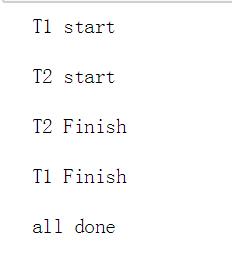python ---thread
Posted 张乐乐章
tags:
篇首语:本文由小常识网(cha138.com)小编为大家整理,主要介绍了python ---thread相关的知识,希望对你有一定的参考价值。
thread 在数据预处理的时候用处不大,因为有GIL 锁
查看thread信息
1 import threading 2 print(threading.current_thread()) 3 print(threading.enumerate()) 4 print(threading.active_count())
定义thread job并开启
1 def thread_job(): 2 print("this is added thread,number is %s"%(threading.current_thread())) 3 4 added_thread = threading.Thread(target=thread_job) 5 added_thread.start()
join()的功能
先运行join的功能,然后再运行join 下面的。
1 import threading 2 import time 3 def thread_job(): 4 print(\'T1 start\\n\') 5 for i in range(10): 6 time.sleep(0.1) 7 print(\'T1 Finish\\n\') 8 9 def T2_job(): 10 print(\'T2 start\\n\') 11 print(\'T2 Finish\\n\') 12 13 14 def main(): 15 added_thread = threading.Thread(target=thread_job,name=\'T1\') 16 thread2 = threading.Thread(target=T2_job,name=\'T2\') 17 added_thread.start() 18 thread2.start() 19 thread2.join() 20 added_thread.join() 21 print(\'all done\\n\')

注释掉 19、20

你也可以添加thread_2.join()进行尝试,但为了规避不必要的麻烦,推荐如下这种1221的V型排布:
thread_1.start() # start T1
thread_2.start() # start T2
thread_2.join() # join for T2
thread_1.join() # join for T1
print("all done\\n")
"""
T1 start
T2 start
T2 finish
T1 finish
all done
"""
利用Queue存储数据
1 from queue import Queue 2 import threading 3 import time 4 5 def job(l,q): 6 for i in range(len(l)): 7 l[i] = l[i]**2 8 q.put(l) 9 10 def multithreading(): 11 q =Queue() #q中存放返回值,代替return的返回值 12 threads = [] 13 data = [[1,2,3],[3,4,5],[4,4,4],[5,5,5]] 14 for i in range(4): 15 t = threading.Thread(target=job,args=(data[i],q)) 16 t.start() 17 threads.append(t) 18 for thread in threads: 19 thread.join() 20 res = [] 21 for _ in range(4): 22 res.append(q.get()) 23 print(res) 24 25 multithreading()
GIL锁
Global Interpreter Lock (GIL). 这个东西让 Python 还是一次性只能处理一个东西.
尽管Python完全支持多线程编程, 但是解释器的C语言实现部分在完全并行执行时并不是线程安全的。 实际上,解释器被一个全局解释器锁保护着,它确保任何时候都只有一个Python线程执行。 GIL最大的问题就是Python的多线程程序并不能利用多核CPU的优势 (比如一个使用了多个线程的计算密集型程序只会在一个单CPU上面运行)。
在讨论普通的GIL之前,有一点要强调的是GIL只会影响到那些严重依赖CPU的程序(比如计算型的)。 如果你的程序大部分只会涉及到I/O,比如网络交互,那么使用多线程就很合适, 因为它们大部分时间都在等待。实际上,你完全可以放心的创建几千个Python线程, 现代操作系统运行这么多线程没有任何压力,没啥可担心的。
线程锁 Lock
lock在不同线程使用同一共享内存时,能够确保线程之间互不影响,使用lock的方法是, 在每个线程执行运算修改共享内存之前,执行lock.acquire()将共享内存上锁,
确保当前线程执行时,内存不会被其他线程访问,执行运算完毕后,使用lock.release()将锁打开, 保证其他的线程可以使用该共享内存。
1 def job1(): 2 global A ,lock 3 lock.acquire() 4 for i in range(10): 5 A+=1 6 print(\'job1\',A) 7 lock.release() 8 def job2(): 9 global A ,lock 10 lock.acquire() 11 for i in range(10): 12 A+=10 13 print(\'job2\',A) 14 lock.release() 15 16 def job1(): 17 global A 18 for i in range(10): 19 A+=1 20 print(\'job1\',A) 21 22 def job2(): 23 global A 24 for i in range(10): 25 A+=10 26 print(\'job2\',A) 27 28 A = 0 29 lock = threading.Lock() 30 t1 = threading.Thread(target=job1) 31 t2 = threading.Thread(target=job2) 32 t1.start() 33 t2.start() 34 t2.join() 35 t1.join()
参考:
https://morvanzhou.github.io/tutorials/python-basic/threading/6-lock/
以上是关于python ---thread的主要内容,如果未能解决你的问题,请参考以下文章